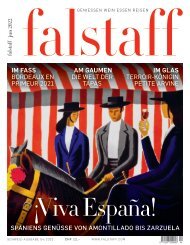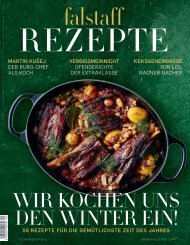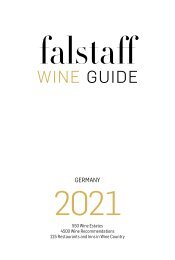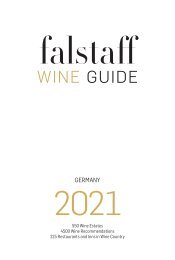You also want an ePaper? Increase the reach of your titles
YUMPU automatically turns print PDFs into web optimized ePapers that Google loves.
AUSTRIA’S GRAPE VARIETIES<br />
ROTGIPFLER<br />
The rare Rotgipfler is a natural cross of Savagnin<br />
x Roter Veltliner, most probably from Austria’s<br />
Thermenregion, and is therefore a<br />
half-sibling of Frühroter Veltliner, Neuburger<br />
and Zierfandler.. Its oldest documentation is<br />
from Styria in 1840. Together with Zierfandler,<br />
it established the reputation of the famous<br />
wines from Gumpoldskirchen. This variety<br />
exists almost exclu sively in Austria,<br />
particularly in its Thermenregion origin. It favours<br />
fertile medium-weight lime soils and<br />
warm hillside locations. It is sensitive to winter<br />
frosts, prone to botrytis, and matures late.<br />
The wine is golden-yellow and possesses a<br />
pronounced bouquet. It is refreshing and<br />
spicy, and for the most part, full-bodied, and<br />
rich in extract and alcohol. It is vinified dry,<br />
off-dry and sweet and is often paired with Zierfandler<br />
in a blend.<br />
ROTER VELTLINER<br />
The origin of this very old variety has not yet<br />
been clearly established. It is likely from Niederösterreich<br />
(Lower Austria), where it is<br />
grown today in small quantities in the<br />
Kremstal and Wagram areas. The Roter Veltliner<br />
places moderate demands on soil, but<br />
high demands on location, requiring warm,<br />
south ern hillside aspects. It is sensitive to frost<br />
and yields are unreliable. Roter Veltliner matures<br />
late. The wine is greenish-yellow, fruity<br />
and fragrant, with a subtle spicy aroma, and<br />
often exhibits racy acidity.<br />
SAUVIGNON BLANC<br />
In its present form, this variety probably<br />
comes from the south of France where it has<br />
been documented since the first half of the<br />
18th century. It originates from a Traminer<br />
crossing, but seems to have developed from a<br />
preliminary stage. It is most common in Styria,<br />
but due to its general popularity is now planted<br />
in all regions. The name “Muskat-Sylvaner”<br />
was permitted until <strong>19</strong>99. The variety<br />
places high demands on location and thrives<br />
on fertile, not overly dry soils. High humidity<br />
is important. It brings moderate, irregular<br />
yields and is sensitive to winter frost. The wine<br />
exhibits a green ish yellow colour and its<br />
grassy spiciness reminiscent of fresh bell peppers<br />
evolves into aromas of asparagus, elderflower<br />
and cassis at high stages of maturity.<br />
Sauvignon Blanc is an elegant, refreshing wine<br />
with racy structure and inimitable, stim ulating<br />
character. The variety is suit able for medium-term<br />
ageing. More potent wines are sometimes<br />
vinified in new oak.<br />
SCHEUREBE<br />
Synonym: Sämling 88<br />
This variety is a cross of Riesling and an unknown<br />
variety, but not Silvaner as was once<br />
suspected. In terms of quality, this is perhaps the<br />
most successful of all the German crossings and<br />
was developed by Dr. Scheu in <strong>19</strong>16. The variety<br />
is valued in Burgenland for noble sweet wines<br />
and in Styria for light, dry, crisp wines. Despite<br />
its quality, the variety is currently declining. It<br />
makes little demand on soil, but high demand<br />
on location. The Scheurebe matures late and<br />
provides moderate yields. Scheurebe wines are<br />
usually golden-yellow, have a subtle, aromatic<br />
bouquet, and exhibit elegant acidity and body.<br />
WEISSBURGUNDER<br />
Synonym: Pinot Blanc, Klevner<br />
Burgundy is considered to be the home of this<br />
highly acclaimed variety as it was documented<br />
there in the 14th century. Pinot is quite prone<br />
to mutation and its different colour variations,<br />
– Pinot Blanc, Pinot Gris, and Pinot Noir – all<br />
have a very similar genetic fingerprint. Weissburgunder<br />
is mainly planted throughout Austria’s<br />
wine regions and makes up 4.3 % of the<br />
© provided<br />
22 falstaff WINE GUIDE <strong>2018</strong>


















